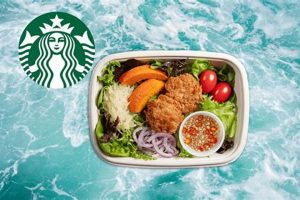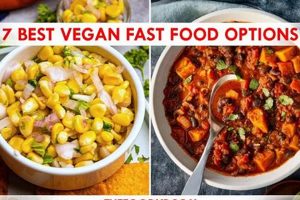The term denotes plant-based alternatives to the traditional smashed burger preparation, referring to menu items that incorporate vegan patties, cheese alternatives, and suitable toppings, all cooked in the characteristic “smashed” style of pressing the patty thin on a hot griddle. An example is a lentil-based patty pressed onto a flat-top grill until crispy, served on a vegan bun with plant-based cheddar and caramelized onions.
The significance lies in catering to the growing demand for plant-based cuisine while retaining the desirable textural elements of a smash burger. This offers a familiar yet ethical and sustainable choice. Historically, burger alternatives were often limited in texture and flavor. The adoption of the “smashed” technique addresses this by creating crispy edges and intensified Maillard reaction flavors even in plant-based patties.
The following sections will delve into the specific types of patties used, the crucial elements of a successful preparation, and the variety of toppings and condiments that complement this culinary style.
Guidance for Smashed Plant-Based Burger Creation
Achieving optimal results with plant-based smashed burgers necessitates careful consideration of patty composition, cooking technique, and ingredient selection. The following tips outline critical factors for success.
Tip 1: Patty Selection is Paramount: Opt for patties specifically formulated for high-heat cooking. Those with a higher moisture content or insufficient binding agents are prone to crumbling when pressed thin. Look for patties that list methylcellulose or similar binders.
Tip 2: Pre-Heating is Essential: Ensure the griddle or flat-top surface reaches a uniformly high temperature before initiating the cooking process. Inadequate heat impedes proper searing and results in a less desirable texture. An ideal temperature is generally between 350-400F (175-200C).
Tip 3: Strategic Smashed Application: Employ a sturdy, flat-bottomed spatula or burger press to apply even pressure across the entire surface of the patty. Aim to achieve maximum surface area contact with the hot griddle for optimal Maillard reaction and crisping. A firm, controlled smash lasting 5-10 seconds is generally sufficient.
Tip 4: Fat Content Considerations: Plant-based patties often lack the inherent fat content of traditional beef. Adding a small amount of oil (such as avocado or canola) to the griddle prior to smashing can significantly enhance searing and prevent sticking. Avoid excessive oil, which can lead to greasiness.
Tip 5: Caramelization Enhancement: Introduce sugars strategically to promote caramelization. Lightly brushing the pressed patty with a mixture of balsamic vinegar and maple syrup can create a flavorful and visually appealing crust. This should be done sparingly to avoid excessive sweetness or burning.
Tip 6: Cheese Alternative Application Timing: Apply plant-based cheese alternatives towards the end of the cooking process, allowing sufficient time for melting without overcooking the patty. Covering the burger with a dome or lid can expedite the melting process.
Tip 7: Bun Selection Matters: Choose a vegan bun that is structurally sound and capable of withstanding the moisture from the patty and toppings. Toasting the bun lightly provides added structural integrity and enhances the overall textural experience.
Adherence to these guidelines can significantly elevate the quality and palatability of plant-based smashed burgers, resulting in a satisfying and flavorful culinary experience.
The following section will explore diverse topping combinations that complement the plant-based smashed burger, further enhancing its appeal.
1. Patty Composition
Patty composition is fundamentally linked to successful plant-based smashed burger creations. The structure and ingredient selection within the patty dictate its behavior under the intense heat and pressure characteristic of the “smash” technique. A poorly formulated patty risks crumbling, sticking to the cooking surface, or failing to develop the desired crispy exterior. For example, a patty relying solely on cooked grains and lacking sufficient binding agents (such as methylcellulose or modified cellulose) will likely disintegrate during the smashing process, resulting in an unappealing texture and diminished flavor.
The protein source and fat content also exert significant influence. Plant-based proteins, such as pea protein, soy protein, or a combination thereof, contribute to the patty’s structural integrity and overall mouthfeel. The presence of fat, often derived from coconut oil or other plant-based sources, facilitates browning and prevents the patty from becoming overly dry. Finding the right balance is crucial. Too little fat results in a dry, crumbly patty, while excessive fat can lead to a greasy, unpleasant texture. A real-world example of a patty optimized for this preparation would be one containing a blend of pea protein, vital wheat gluten (if not catering to gluten-free diets), and a moderate amount of refined coconut oil, providing both structure and desired Maillard reaction.
In conclusion, informed selection and careful formulation of the patty are paramount for achieving a palatable and structurally sound plant-based smashed burger. Understanding the interplay between protein sources, binding agents, and fat content is essential to avoid common pitfalls and to ensure the patty can withstand the high-heat and pressure inherent in the smashing process. This understanding contributes directly to expanding the availability and desirability of plant-based menu options.
2. Searing Technique
The searing technique is a critical element in the successful execution of plant-based smashed burgers. It directly impacts the development of flavor, texture, and visual appeal, compensating for differences between plant-based and traditional beef patties.
- Surface Contact Optimization
Effective searing requires maximizing contact between the patty and the hot cooking surface. In the context of plant-based patties, which may have irregular shapes or inconsistencies in density, ensuring complete contact is crucial for uniform browning. Tools such as a heavy, flat-bottomed spatula or a burger press are necessary. Uneven contact results in pale, unseared areas, diminishing the burger’s overall flavor profile.
- Temperature Control and Maillard Reaction
Searing relies on the Maillard reaction, a chemical process between amino acids and reducing sugars, to create complex flavors and a desirable crust. Plant-based patties often require higher cooking temperatures than beef to achieve a similar level of browning. Precise temperature control is essential to avoid burning the exterior while ensuring the patty is heated through. Monitoring the patty’s color and aroma provides indicators of successful searing.
- Fat Utilization for Enhanced Browning
Plant-based patties often contain less fat than their beef counterparts. Adding a small amount of oil, such as canola or avocado oil, to the cooking surface facilitates heat transfer and promotes browning. The oil creates a conductive layer that helps the patty develop a crispy crust. The type and amount of oil should be carefully considered to avoid excessive greasiness or imparting unwanted flavors.
- Timing and Pressure Management
The duration and intensity of the “smash” are critical. Applying too little pressure or searing for an insufficient time results in a pale, undercooked patty. Conversely, excessive pressure or prolonged searing can lead to a dry, overcooked result. Experienced cooks adjust the timing and pressure based on the patty’s composition and the griddle’s temperature, regularly monitoring the patty’s color and texture to achieve optimal searing.
In summation, the searing technique is not merely a method of cooking but a vital component in transforming plant-based patties into compelling smash burger options. Optimizing surface contact, carefully managing temperature and fat utilization, and mastering the timing and pressure of the smash contribute significantly to the overall success and consumer acceptance of plant-based alternatives. Consistent execution of these techniques results in a product that effectively mimics the sensory experience of traditional smashed burgers, contributing to the broader adoption of plant-based diets.
3. Cheese Alternatives
The selection and application of cheese alternatives are integral to the success of smash burger vegan options. Given the established role of cheese in traditional smash burgers contributing moisture, richness, and a characteristic melt replicating these qualities with plant-based alternatives is crucial for consumer satisfaction. The absence of a suitable cheese alternative can render a vegan smash burger dry, texturally lacking, and ultimately less appealing. Consequently, the evolution of plant-based cheese technology directly influences the viability and market acceptance of smash burger vegan options. For instance, the development of cashew-based cheeses with improved melting properties has enabled restaurants to offer plant-based smash burgers that more closely mimic the sensory experience of their dairy-based counterparts.
The cause-and-effect relationship between cheese alternatives and the overall appeal of vegan smash burgers is evident in product reviews and consumer feedback. Smash burger vegan options that incorporate low-quality cheese alternativesthose that do not melt properly, exhibit off-flavors, or possess an undesirable textureconsistently receive lower ratings. In contrast, versions using high-quality, carefully selected cheese alternatives tend to be more positively received. Practical applications of this understanding involve chefs and food developers rigorously testing various cheese alternatives to identify those that perform optimally under the high heat and smashing conditions characteristic of this preparation method. This includes evaluating melting behavior, flavor compatibility with other ingredients, and structural integrity under pressure. A restaurant experimenting with a new vegan menu item may, for example, compare several brands of plant-based cheddar slices, assessing their melting point, flavor profile, and ability to adhere to the patty.
In summary, the strategic incorporation of appropriate cheese alternatives is not merely an ancillary consideration but a fundamental determinant of success for smash burger vegan options. The challenges lie in identifying alternatives that accurately replicate the key functional and sensory properties of dairy cheese. Ongoing research and development in plant-based cheese technology are essential for overcoming these challenges and for further enhancing the appeal and market penetration of vegan smash burgers. This, in turn, contributes to the broader goal of promoting sustainable and ethical food choices.
4. Topping Combinations
Topping combinations are integral to elevating plant-based smashed burgers from mere substitutes to compelling culinary options. Strategic selection of toppings addresses potential deficiencies in plant-based patties, enhancing flavor, texture, and overall satisfaction. A lack of thoughtful topping pairings can render a plant-based burger bland and uninspired.
- Umami Enhancement
Plant-based patties often lack the inherent umami of beef. Toppings such as caramelized onions, roasted mushrooms, sun-dried tomatoes, and vegan Worcestershire sauce contribute umami notes, creating a more savory and satisfying experience. For example, incorporating a layer of sauted shiitake mushrooms glazed with balsamic vinegar adds depth and complexity to the flavor profile.
- Texture Contrast
Texture is crucial in burger satisfaction. Crisp lettuce, crunchy pickles, and toasted nuts provide contrast to the softer patty and bun. Adding pickled red onions offers a tangy bite alongside a pleasant textural element, preventing the burger from becoming monotonous.
- Acidity Balance
Rich plant-based cheeses and patties benefit from acidic elements to cut through the richness. Pickled vegetables, sauerkraut, or a tangy vinaigrette-based slaw contribute acidity, balancing the overall flavor profile. A smear of Dijon mustard or a drizzle of balsamic glaze also serves this purpose.
- Moisture Enhancement
Plant-based burgers can sometimes be drier than their beef counterparts. Adding juicy toppings, such as sliced tomatoes, avocado, or a creamy vegan aioli, helps to provide moisture and prevent the burger from feeling dry. A layer of roasted red peppers adds both moisture and sweetness.
By thoughtfully selecting and combining toppings that address the specific characteristics of plant-based patties, chefs can create smash burger vegan options that rival or exceed the appeal of traditional burgers. The synergy between the patty and its toppings is critical in delivering a complete and satisfying culinary experience, further promoting the adoption of plant-based diets.
5. Bun Integrity
Bun integrity represents a crucial, often overlooked, factor in the overall success of smash burger vegan options. It directly impacts the structural stability, textural harmony, and ultimately, the eating experience. A compromised bun undermines the intended characteristics of the entire dish, regardless of the patty’s quality or topping selection.
- Structural Support
Vegan buns, often lacking the gluten structure of traditional wheat-based buns, must possess sufficient structural integrity to contain the smashed patty, toppings, and sauces. A bun that crumbles or disintegrates under pressure renders the burger difficult to handle and consume. Examples of structurally sound options include brioche-style vegan buns and potato rolls formulated with alternative binding agents like modified cellulose. Failure to prioritize structural support leads to a messy and unsatisfying experience.
- Moisture Resistance
Smashed burgers, both traditional and vegan, tend to be juicier due to the cooking method. The bun must effectively resist absorbing excessive moisture from the patty and toppings, preventing it from becoming soggy. A toasted bun provides a barrier against moisture penetration, preserving its texture and structural integrity. Untoasted buns are prone to rapid disintegration, particularly when paired with wetter toppings like tomatoes or vegan aioli.
- Flavor Compatibility
The bun’s flavor profile must complement, not compete with, the other components of the burger. A neutral-tasting bun allows the flavors of the patty, cheese alternative, and toppings to shine. Overly sweet or strongly flavored buns can clash with the savory elements of the burger, creating a discordant culinary experience. Examples of complementary buns include those with a subtle tang from sourdough or a slight richness from potato flour.
- Textural Harmony
The bun contributes significantly to the overall textural experience of the burger. A soft, yielding bun provides a pleasant contrast to the crispy edges of the smashed patty and the various textures of the toppings. Conversely, a tough or overly dense bun can detract from the overall enjoyment. Factors contributing to desirable texture include the bun’s crumb structure and its ability to absorb moisture without becoming gummy.
The preceding facets highlight the critical role of bun integrity in the realm of smash burger vegan options. Selecting a bun that provides adequate structural support, moisture resistance, flavor compatibility, and textural harmony is essential for creating a satisfying and cohesive dish. Neglecting these considerations compromises the overall eating experience, diminishing the appeal of even the most skillfully prepared plant-based smashed burger. As vegan cuisine gains prominence, attention to detail, including the selection of the appropriate bun, becomes paramount in delivering high-quality and compelling alternatives.
Frequently Asked Questions
The following addresses common inquiries regarding the creation, preparation, and characteristics of plant-based smashed burger options.
Question 1: What distinguishes a plant-based smashed burger from a conventional plant-based burger?
The defining characteristic is the cooking method. A smashed burger, regardless of its composition, involves pressing the patty thin onto a hot griddle to maximize surface contact and create a crispy exterior. This technique is applied to plant-based patties to enhance texture and flavor development.
Question 2: Are all plant-based patties suitable for the smashed burger preparation method?
No. Patties lacking sufficient binding agents or structural integrity are prone to crumbling when pressed thin. Optimal results require patties specifically formulated to withstand the high-heat and pressure involved in the “smash” technique.
Question 3: How does the fat content of a plant-based patty impact the outcome of a smashed burger?
Fat contributes to browning and prevents the patty from sticking to the griddle. Since plant-based patties often have less inherent fat than beef, adding a small amount of oil to the cooking surface is frequently necessary to achieve optimal searing.
Question 4: What are the key considerations when selecting a vegan cheese alternative for a smashed burger?
Melting properties, flavor compatibility, and textural characteristics are paramount. The cheese alternative should melt smoothly and evenly, complement the overall flavor profile, and possess a texture that approximates traditional dairy cheese.
Question 5: What role do toppings play in enhancing the flavor and texture of plant-based smashed burgers?
Toppings address potential deficiencies in plant-based patties, adding umami, acidity, texture contrast, and moisture. Thoughtful topping combinations elevate the overall sensory experience and contribute to consumer satisfaction.
Question 6: Why is bun selection important for plant-based smashed burgers?
The bun provides structural support, resists moisture absorption, complements the flavor profile, and contributes to the overall textural harmony of the burger. A compromised bun detracts from the intended characteristics of the entire dish.
In summation, successful plant-based smashed burgers require careful attention to patty composition, cooking technique, cheese alternative selection, topping combinations, and bun integrity. Each element contributes significantly to the overall quality and appeal of the final product.
The following section will explore potential future trends in the development of plant-based smashed burger technology.
Conclusion
This exploration of smash burger vegan options has addressed crucial aspects from patty composition to bun integrity, underscoring the necessity for meticulous execution in each stage. Achieving parity with, or surpassing, traditional beef smash burgers necessitates a comprehensive understanding of ingredient interactions and cooking techniques specific to plant-based alternatives. The development and refinement of suitable cheese alternatives and the strategic selection of toppings further contribute to a palatable and appealing final product.
The continued innovation within the plant-based culinary sector holds the potential to further elevate smash burger vegan options, broadening their appeal to a wider consumer base. Ongoing research into plant-based protein sources, binding agents, and fat alternatives will undoubtedly lead to improved patty formulations. The industry must prioritize continued refinement and optimization to fully realize the potential of this culinary adaptation, solidifying its position within the evolving landscape of sustainable food choices.







